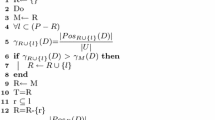Abstract
The applications of feature selection increase rapidly due to its diverse areas. Classification is a part of feature selection, which is used in a large number of the dataset. Sometimes, due to a large number of features in high dimensional datasets, performance may decrease. So, in this chapter, an efficient feature selection technique is proposed by the fusion of central force optimization (CFO) and rough set. The CFO is used to optimize the several parameters of the proposed method, where the rough set is used to established relationship between noisy and imprecise information or the parameters. The combination of both helps to estimate uncertainties of the proposed problem. The proposed fusion method is an intelligent technique which is compared with the standard technique named as genetic algorithm (GA) based on some valid metrics. Finally, it shows that the proposed method outperforms the metrics in terms of accuracy and quality.
Access this chapter
Tax calculation will be finalised at checkout
Purchases are for personal use only
Similar content being viewed by others
References
Sung-Bae, C. H. O., & Hong-Hee, W. O. N. (2003). Data mining for gene expression profiles from dna microarray. International Journal of Software Engineering and Knowledge Engineering, 13(06), 593–608.
Banerjee, M., Mitra, S., & Banka, H. (2007, July). Evolutionary rough feature selection in gene expression data. Systems, Man, and Cybernetics, Part C: Applications and Reviews, IEEE Transactions on, 37(4), 622–632.
Xiong, W., & Wang, C. (2009. August). A hybrid improved ant colony optimization and random forests feature selection method for microarray data, pp. 559–563.
Xue, B., Zhang, M., & Browne, W. N. (2013, December). Particle swarm optimization for feature selection in classification: A multi-objective approach. Cybernetics, IEEE Transactions on, 43(6), 1656–1671.
AlSukker, A., Khushaba, R. N., & Al-Ani, A. (2010, October). Enhancing the diversity of genetic algorithm for improved feature selection, pp. 1325–1331.
Pawlak, Z. (2002, March). Rough set theory and its applications. Journal of Telecommunications And Information Technology.
Wang, X., Xia, W., Jensen, R., Teng, X., & Yang, J. (2007). Feature selection based on rough sets and particle swarm optimization. Pattern Recognition Letters, 28, 459–471.
Liu, Y., & Tian, P. (2015). A multi-start central force optimization for global optimization. Applied Soft Computing, 27, 92–98.
Das, S. K., Samanta, S., Dey, N., & Kumar, R. (2020). Design frameworks for wireless networks. Springer.
De, D., Mukherjee, A., Das, S. K., & Dey, N. (2020). Nature inspired computing for wireless sensor networks.
Dey, N. (2017). Advancements in applied metaheuristic computing. IGI Global.
Dey, N., Ashour, A., & Bhattacharyya, S. (2020). Applied nature-inspired computing: algorithms and case studies. Springer.
Bouamama, S., Blum, C., & Fages, J.-G. (2019). An algorithm based on ant colony optimization for the minimum connected dominating set problem. Applied Soft Computing, 80, 672–686.
Omran, Mahamed G. H., & Al-Sharhan, S. (2019). Improved continuous ant colony optimization algorithms for real-world engineering optimization problems. Engineering Applications of Artificial Intelligence, 85, 818–829.
Chatterjee, S., Hore, S., Dey, N., Chakraborty, S., & Ashour, A. S. (2017). Dengue fever classification using gene expression data: a pso based artificial neural network approach. In: Proceedings of the 5th International Conference on Frontiers in Intelligent Computing: Theory and Applications. Springer, pp. 331–341.
Jagatheesan, K., Anand, B., Samanta, S., Dey, N., Ashour, A. S., & Balas, V. E. (2017). Particle swarm optimisation-based parameters optimisation of pid controller for load frequency control of multi-area reheat thermal power systems. International Journal of Advanced Intelligence Paradigms, 9(5–6), 464–489.
Bera, S., Das, S. K., & Karati, A. (2020). Intelligent routing in wireless sensor network based on african buffalo optimization. In: Nature Inspired Computing for Wireless Sensor Networks (pp. 119–142). Springer.
Das, S. K., & Tripathi, S. (2018). Intelligent energy-aware efficient routing for manet. Wireless Networks, 24(4), 1139–1159.
Das, S. K., & Tripathi, S. (2017). Energy efficient routing formation technique for hybrid ad hoc network using fusion of artificial intelligence techniques. International Journal of Communication Systems, 30(16), e3340.
Formato, R. (2009). Central force optimization: A new deterministic gradient-like optimization metaheuristic. OPSEARCH, 46, 25–51.
Kumar Huda, R., & Banka, H. (2019). Efficient feature selection and classification algorithm based on pso and rough sets. Neural Computing and Applications, 31(8), 4287–4303.
Mitra, S., & Acharya, T. (2003). Data mining: Multimedia, soft computing and bioinformatics. New York: Wiley.
Author information
Authors and Affiliations
Corresponding author
Editor information
Editors and Affiliations
Rights and permissions
Copyright information
© 2021 The Author(s), under exclusive license to Springer Nature Singapore Pte Ltd.
About this chapter
Cite this chapter
Huda, R.K., Banka, H. (2021). Feature Selection Method Using CFO and Rough Sets for Medical Dataset. In: Das, S.K., Dao, TP., Perumal, T. (eds) Nature-Inspired Computing for Smart Application Design. Springer Tracts in Nature-Inspired Computing. Springer, Singapore. https://doi.org/10.1007/978-981-33-6195-9_4
Download citation
DOI: https://doi.org/10.1007/978-981-33-6195-9_4
Published:
Publisher Name: Springer, Singapore
Print ISBN: 978-981-33-6194-2
Online ISBN: 978-981-33-6195-9
eBook Packages: EngineeringEngineering (R0)




